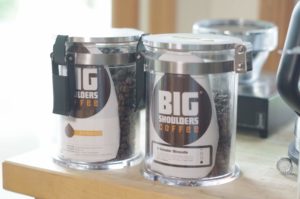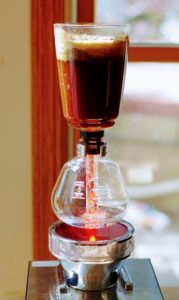

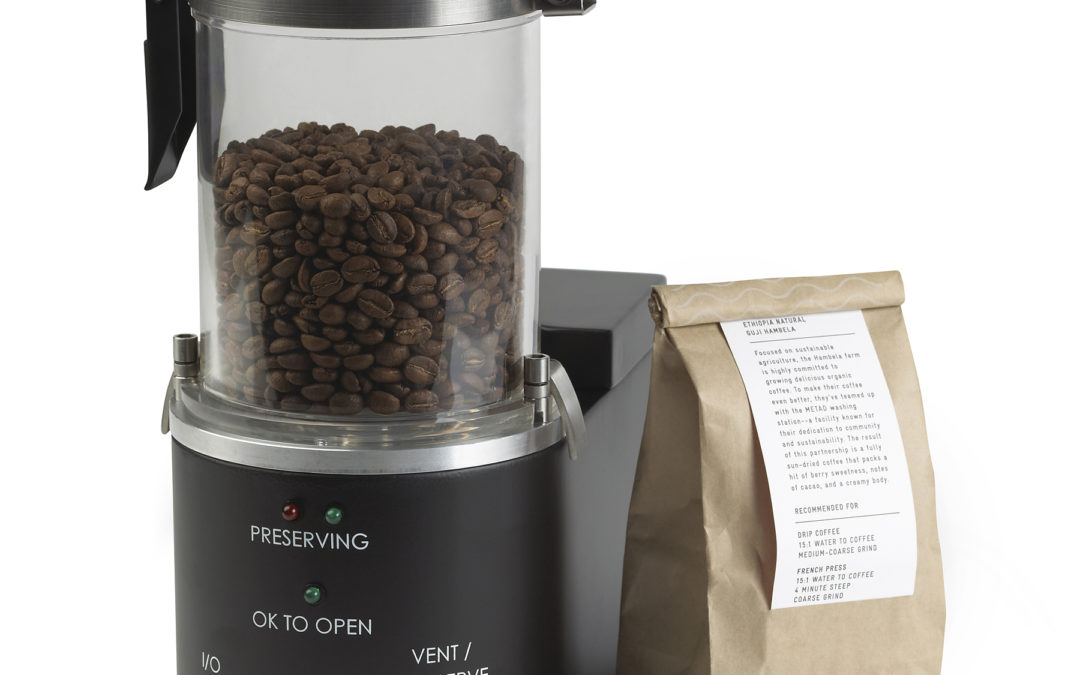
Coffee Freshness System. Everlasting Beans!
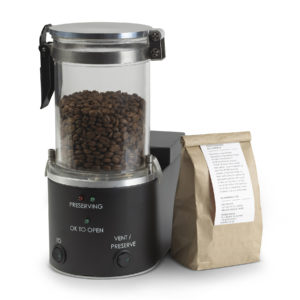 I know many are obsessed with single origin varietals. The industry has done a great job of marketing these. How you brew that coffee is also getting to be widely known as important. Our Four-Way Flight class, originated by Marcus Boni at CoffeeCon is one of our most popular. The idea that coffee might taste different when brewed using a different coffee maker is well demonstrated in this presentation. Sometimes it’s dramatic.
I know many are obsessed with single origin varietals. The industry has done a great job of marketing these. How you brew that coffee is also getting to be widely known as important. Our Four-Way Flight class, originated by Marcus Boni at CoffeeCon is one of our most popular. The idea that coffee might taste different when brewed using a different coffee maker is well demonstrated in this presentation. Sometimes it’s dramatic.
The final frontier of coffee is freshness. It’s the biggest current weakness in coffee compared to say craft beer or wine. Beer is shelf stable for months. Wine is for years, although I know some wines age well, while others don’t. But, over a few months no problem. It’s therefore not unusual, and in fact it’s considered desirable for a wine enthusiast to stock multiple wines for food matching or just plain variety.
How about coffee enthusiasts? Come on. Admit it. You culinary coffee relationships have been condemned to serial monogamy. You buy one, drink it repeatedly in its youth until it’s gone. Then move on to another. While this practice may seem like a good compromise, it limits your enjoyment. For one thing, your wine and beer buddies get to drink whatever kind of beer pleases them.
So, what can we as coffee enthusiasts do? Well, you can freeze coffee. “Oh, no!”, you say. Well some of us do this unashamedly, although much of the industry claims it results in everything from freezer burn to less-than-full flavor. “No one freezes oil” say the geeks. I’m not taking a side on this in this article, but let’s for the moment say that no one claims it’s a first choice, nor as good as fresh-roasted unfrozen coffee.
One-way valve bags were the industry’s great hope of the 90s. This invention, which basically lets gas escape, but no air in, was sold as The Answer. What many of us found, or at least I did, was it was better than nothing. The valve offers protection against outside competing scents. Yes, it allows bean de-gassing in an otherwise sealed bag. But, it slow, rather then prevents staling. Consensus seems to indicate it does a good job of prolonging a bag of beans for a few months, maybe as long as six. Best results are claimed if the beans are scrupulously packed in a nitrogen-flushed environment.
Good so far, right? However, when you purchased that six-month-old sack and break the seal, consensus is they stale quickly, like one-too-many facelifts on a Hollywood star. That fountain-of-youth pill suddenly wears off. I know people, I think sincere ones, in the coffee industry who swear by one-way valve bags, but those are often the same folks who don’t really believe in the whole “fourteen days from the roaster” dogma anyway. I suppose I do, so we gradually drift apart.
The Coffee Freshness System, or CFS for short, is a mechanical storage system consisting of a method of sealing a canister, which you fill with beans. After locking it tight, you simply place it on a mother unit, which draws all the oxygen from it. Meanwhile, Co2 from a replaceable can. This is the ingenious part as it effectively emulates the same effect as nitrogen. When you open the canister, up to a month or more later, to make coffee, the beans are still fresh, presumably as fresh to taste, smell and brew as when you sealed them. I must admit at first I was dubious, but intrigued.
The is of preserving one coffee is enough. But, suddenly it occurs to me that we have a potential revolution on our hands. As individual canisters are sold separately, it is possible to stock several coffees in your home, creating a coffee wine-cellar (coffee cellar?) so to speak. Imagine inviting a friend to drop over and have them pick their coffee the way a wine collector lets you pick a fine wine to open and share.
I knew I had to try this. I begged them to loan me a sample, which was easy.
Why easy?
Apparently the trade doesn’t see the value of this invention. My thought is, “Are they Crazy?” I can’t understand. I asked several of my roaster friends. None of them seemed very excited by it. It took me a while to analyze this but eventually I realized why. People who work at a coffee roasting plant, or even near a small shop roaster are deluged with fresh coffee. They likely aren’t wanting for fresh beans to take home each evening, so they just grab enough to fill tomorrow morning’s brew basket. I’ve even found doing my FB live video conversations with roasters that many do not even brew before coming to work. Why not just wait and sample some when they arrive each morning?
WELL, KEV? HOW WELL DOES IT WORK?
I’m going to tell you after testing for several months I consider the Coffee Freshness System a major breakthrough. I used it one canister several bags of beans, keeping it for a period of weeks each time, which no discernible aroma or scent reduction. It is amazing to have beans for a period past a month or two and break it open and brew it and have it foam up as the water first hits, just as you would with just-roasted coffee.
For a second canister, I grabbed a particularly tasty Kenya Coffee from Big Shoulders in Chicago. These beans were highly rated by the Coffee Review and had a particularly unique flavor footprint. I kept a small amount for nearly four months, then opened the canister and brewed. Again, no difference, at least none I could detect.

The end result. I took three-month old beans from my Coffee Freshness System canister and brewed a Hario V60 batch. Notice the gentle foam, signaling fresh coffee. Oh yeah. It tasted great!
I consider it a coffee enthusiast game changer. I literally did invite friends over and let them choose their bean, as I’ve let them choose which brewing method in the past. I am now considering amassing more canisters. Warning: You are going to want to do this to maximize the social potential of this invention.
THE COFFEE: HIGH BUT WORTH IT
The Coffee Freshness System is not cheap at $500. It is well-made. I’ve noticed no bugs with it, impressive especially for what must be an early generation product. Some larger companies with more to spend on R&D and tooling have far more tweaks in their early product issues. Robert Wallach, Coffee Freshness System’s primary inventor and founder, is to be congratulated on his invention. Wallach is a coffee enthusiast who likely created this product for his own use, hence his passion and resolve to make it right the first time. Frankly, coming from a video and audio hobbyist background, this price tag is high but not outrageous. I live in a world where hobbyists spend that much on turntables and styluses for their high-end turntables. Wine connoisseurs pay this much for a single bottle of an historic vintage. My older brother paid this much for his first CD player.
It’s an invention that finally makes it possible to collect coffees. Think about that!
Podcast: Play in new window | Download
Hario Syphon: Ultimate Brewing for the Enthusiast
I’ve waited forever to do this review. Why? I don’t know. Words fail me when discussing syphons, which used to be called vacuum makers, glass makers or sometimes percolators. You likely think I mean the dreaded pumping percolator, which became shortened to the single word designation, but I don’t. The two used to be distinguished from each other, but as the vacuum version got phased out, the pumping percolator got called a percolator. Since then, it’s been blamed for virtually taking the coffee industry down, but that’s another story… and blog post!
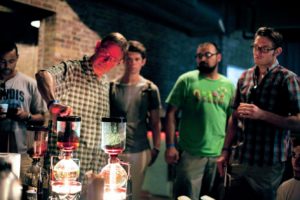
CoffeeCon Syphon class taught by long-time pal Charlie Sarin (thought not pictured). The Syphon is open-ended tech, with different presenters offering their individualized hacks and variations on the theme.
The Hario Syphon is one of two relatively popular and widely available syphon brewers. The other is made by Bodum and deserves its own review. Let’s take the Hario syphon and examine its strengths, and any potential weaknesses. It’s really not hard to understand a syphon. The lower bowl is really a kettle, where the water is heated in order to make coffee. The two bowls are fitted together. Once the water is heated to nearly a boil, hot air in the lower bowl expands, forcing the near-boiling water up through the upper bowl’s tube, through a filter where it starts bubbling as if it’s boiling – it’s not. At this point the barista (at home, you or me) adds finely ground coffee to the upper bowl and stirs it swiftly so it starts the extraction process. After roughly a minute, the siphon is removed from heat and the brewed coffee travels downward, as cooling air in the bowl below creates a vacuum (hence the original name) and drawing the coffee through the filter, where the spent grounds are trapped. When the coffee liquid is all down below, the two bowls are carefully detached (they’re hot!) and the lower bowl simply becomes a serving vessel.
At this point, lots of question should come to mind. For this reason, I’m inserting an FAQ here.
Syphon FAQ
- Does the syphon boil to make coffee? No, the water never boils. It remains at a near-ideal 200°F for the duration of the brewing contact time. The bubbles that appear are more expanding air being released as gas expands in the lower bowl. If just looks like it’s boiling.
- Why finer than drip grind? The siphon’s contact time between hot water and grounds is roughly two to three minutes, approximately half that of most drip brewers. You can grind finer, which reduces grounds surface area exposed to the hot water and the overall beverage strength will even out. Note: Automatic syphon brewers may take drip grind. Follow your maker’s recommendation.
- How did we get so lucky that the temperature in the upper bowl happens to be 200°F? We didn’t. Truth is, the standards that recommend 200°F brewing temperatures were developed by observing a siphon brewer and measuring its temperature. That temperature became the de facto ideal recommended extraction temperature for various brewing methods. Note, the syphon naturally brews at 200F, but if for some reason you want a lower or higher temperature, you’d best choose another method.
-
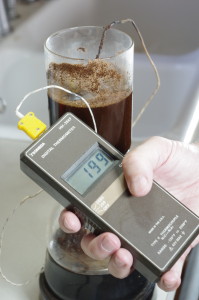
Competitor’s syphon compared. All syphons are reliable at achieving 200F brewing temperatures. Differences are durability, capacity and ease of use. Hario’s excels at all three.
Why wait until the water all goes to the top before adding the ground coffee? It’s the most reliable way to time the contact time, which must be done for consistent results. But, you don’t have to. There are several ways to use a siphon. I’m just giving you the one I’ve found works best in my experience.
- No matter how long I wait, all the water never really rises into the upper bowl. What am I doing wrong? Nothing. All the water will never rise into the bowl. Just understand, it doesn’t have to. All the water never needs to be in contact with the grounds. However, all of the grounds do need to be in contact with the water in the upper bowl.
- Is stirring necessary? Yes, I think so. I realize so-called automatic syphons don’t require nor recommend it. These designed used a developed force to propel the water up into the upper bowl and agitate the grounds, which were added before pressing the on button. This simplified method seemed to work, but I think the manual glass method used by Hario (and others) works best when the end user waits for the water to be mostly up in the upper bowl, adding the grounds and immediately stirring to make sure all the grounds are enrolled in the extraction process. The second stir is done because, on occasion, the grounds re-clump together during the minute or so after the initial stir. I realize I’m insisting upon being thorough here, but you may as well learn to do it right. It happens to me often enough that I think it’s worth sharing as a step.
How Did We Test the Hario?
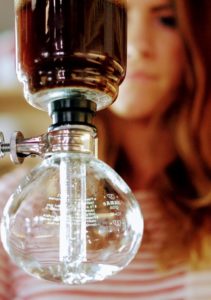
Note bubbling, boiling water in lower bowl during upper bowl brewing. This boiling water has no effect on brewing process, nor is it cause for concern that all the water never attends the extraction process. The syphon brewer is an excellent method.
I tested the Hario using it precisely as I described above. However, there are a few options for you to choose. The filter for instance. Hario supplies both a metal permanent filter and a cloth filter. As a long time syphon fan, to me there is no choice. I prefer cloth as the definitive filter of choice with this method. Metal is fine, but it does let some particulate through and into the final cup. While hardly objectionable and certainly never to the point of being described as sludge, I simply prefer the viscosity and taste of coffee filtered by cloth. To me it offers the ultimate coffee mouthfeel. While cloth filters are not permanent, they do last a month or more if carefully rinsed and stored. They take no more care than the metal permanent filter and they are renewable and inexpensive. I misplaced the one that came with the brewer and didn’t have the nerve to request more from Hario. I went online and purchased some from Amazon for around $5 shipped Prime. About a year’s supply for me. I can’t complain.
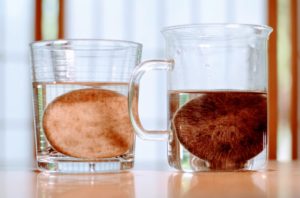
On the left is a fresh cloth filter, after its first use. Right is a two-week-old filter. Notice discoloration begins immediately and darkens with each use, regardless of scrubbing. Works fine regardless. I suggest not worrying about discoloration which seems to have little effect on cup taste.
Don’t be a Purist. The benefits of pre-heating water
One thing I recommend. Don’t pour cold water directly into the syphon for heating. Boil it in a separate kettle. It saves time and energy. I just used a nearby BonaVita kettle but any one will do. I set it to 203°, my normal drip set temperature and used its gooseneck to carefully pour the near-boiling water into the lower syphon bowl. Then I placed the syphon bowl on a heat source. I guess I qualify as a barista because Hario supplied me with an infrared beam heater. I do not know if these heaters are available to the public, but if they are, I highly suggest one if you are committed to syphon long-term. They are simply so easy to use. They also illuminate the process beautifully. Admit it. Part of the syphon’s allure is its theatrical visual as it does its stuff. The beam heater captures all this in its glory.
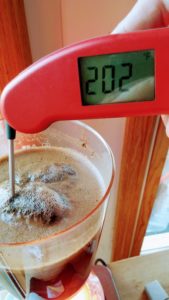
Looks like it’s boiling, but it’s not. The upper bowl, where extraction takes place, is typically within a few degrees of 200F. Many consider this ideal contact temperature.
Beam Heaters versus Flame
A check online of beam heaters tells me it’s at this writing a $250 option. Meanwhile a flame lamp is easy and inexpensive at around $30. Frankly, some baristas tell me they think it’s the ideal way to brew with the syphon. More responsive and direct heat using the flame. If you preheat it, it takes very little time. If you don’t, the beam heater is still too slow. Visually, the lamp gives very little to the beam heater. Both make great coffee. Your call.
Is the Syphon Hard to Use?
The Syphon is not hard to use. It does take some effort and attention, but it’s not hard. The method is actually very reliable and, assuming you agree with the industry’s standards, the syphon follows them perfectly. As I said, it was the model for those standards.
Here are a few potential cons to syphon brewing.
- Thorough cleaning. Not dishwasher safe. As far as I know you cannot just pop the Hario syphon parts into our dishwasher. They require hand washing. You need to thoroughly rinse and perhaps use a little mild or unscented detergent to clean a syphon before putting it away after using. It’s not difficult. The Hario syphon is substantial. It is far better made tempered glass than most others I’ve tried over the years. Still, while hot all syphons are more fragile than cold.
- Syphons get hot. I just finished teaching a syphon class at CoffeeCon NY in Brooklyn. There were two small children in the first row. I wasn’t worried at all, but know that I would always use care when brewing in a home with children. The parts get hot, near-boiling water if traveling up and down in the unit. The beam heater or lamp both get even hotter to do their job. It’s not a unit to ever leave unattended. However, I also made stovetop French fries the other evening when my family was over, and all the same risks remain. Same cautions.
- A cloth filter takes an extra step. It must be thoroughly rinsed and a drop of detergent may be helpful as well to keep it free from oil buildup. It never looks clean after initial staining, but practical use has shown me this means little and doesn’t in my opinion compromise its effectiveness in the coffee making process.
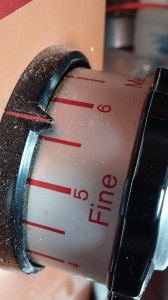
Grind fineness depends upon contact time. The Hario typically takes a grind finer than drip coupled with a 3 minute contact time.
Conclusion
Do you need a syphon? Of course not. The question is akin to asking, “Do I really need an iPad? There’s virtually nothing you can do on an iPad you can’t accomplish on a laptop or other mobile device. The point is it’s ideal for some situations and uses. Same with a Syphon. I know of no better, more thorough and reliable extractor of coffee oils than the Syphon. It never needs to be de-limed with citric acid. Its filtration contains little or no plastic that can become smelly with time and use. The syphon is the best method of extracting from all the grounds. No matter how thoroughly you use drip, most drip cone designs contain some “trouble zones” where grounds in those areas are likely to be less extracted. The syphon’s natural bubbling acts as an extraction facilitator, using what Bunn Corporation calls “turbulence” throughout the contact time. The very dry spent grounds observed after the finished coffee beverage has been drawn down below is evidence of the effectiveness of the final separation of brew from grounds of the syphon.
I can’t imagine being a coffee enthusiast without owning a syphon. And, Hario makes one of the best; perhaps the best.
Podcast: Play in new window | Download
“How to Brew Old Coffee” article. For Real?
I admit I was surprised when the highly regarded Fellow coffee maker manufacturer posted this on their site. I was surprised mostly because it was both innovative and, upon reflection, largely true. Roasted coffee freshness is an elephant-in-the-room issue in the...
Caroline Bell’s Cafe Grumpy Interview
I have always been intrigued by Café Grumpy. Never have I heard so many scary rumors of the tough love treatment of consumer electronics, coupled with praise for their beverages. Such media luminaries as Bruce Cost (creator of my favorite ginger ale) to HBO Girl’s...
Intuition, Not Measurements. Hansa Coffee’s Tom Maegdlin
I met Tom at CoffeeCon Chicago 2015. He impressed me first with the coffee, then with his sense of humor. Finally, one day over a cup of coffee at his North Shore Hansa Coffee Libertyville location, he mentioned that he doesn't brew using any gauges or scales. I saw...
A True Consumer’s Publication: Coffee Lovers Magazine’s Joseph Robertson
Since written word began the word has been a powerful catalyst in developing any culinary art. Just as Julia Child helped spawn a new era in home cooking, writers like wine's Robert W Parker and coffee's Kenneth Davids helped foster our quest for knowledge and...
Nitro: Coffee as Beer?
"Have a cold one!" How often do we receive this invitation? I have consumed around two or three beers in my entire lifetime. But, I'd have my eyes closed if I didn't realize how popular beer has become, and how much it matches coffee's complexity. My first taste of...
The Secret to Finding the Best Blueberries: Jeff Jaeger Interview
What do blueberries have to do with coffee? Well, they're both fruits and both have complex flavors and require knowing something to find the best. I've known Jeff Jaeger for many years as I've found his blueberries to be savory season after season. He's also kind of...
Hario NXA-5 “Next” 5-Cup Syphon Coffee Maker
The Hario Syphon is perhaps the ultimate quality siphon, also long-known as a vacuum coffee maker. The Syphon works on the principal that near-boiling hot water in an enclosed lower vessel releases steam that expands, forces the hot water up through a tube into the...
Bonavita BV1500S 5 cup Automatic drip brewer
Bonavita practically owns what might have once been called “The Chevy” market. This meant, again at one time, a good quality, well designed product that was easy to use and maintain. It had no stunning features, but was priced for everyman. I suppose in automobiles...



